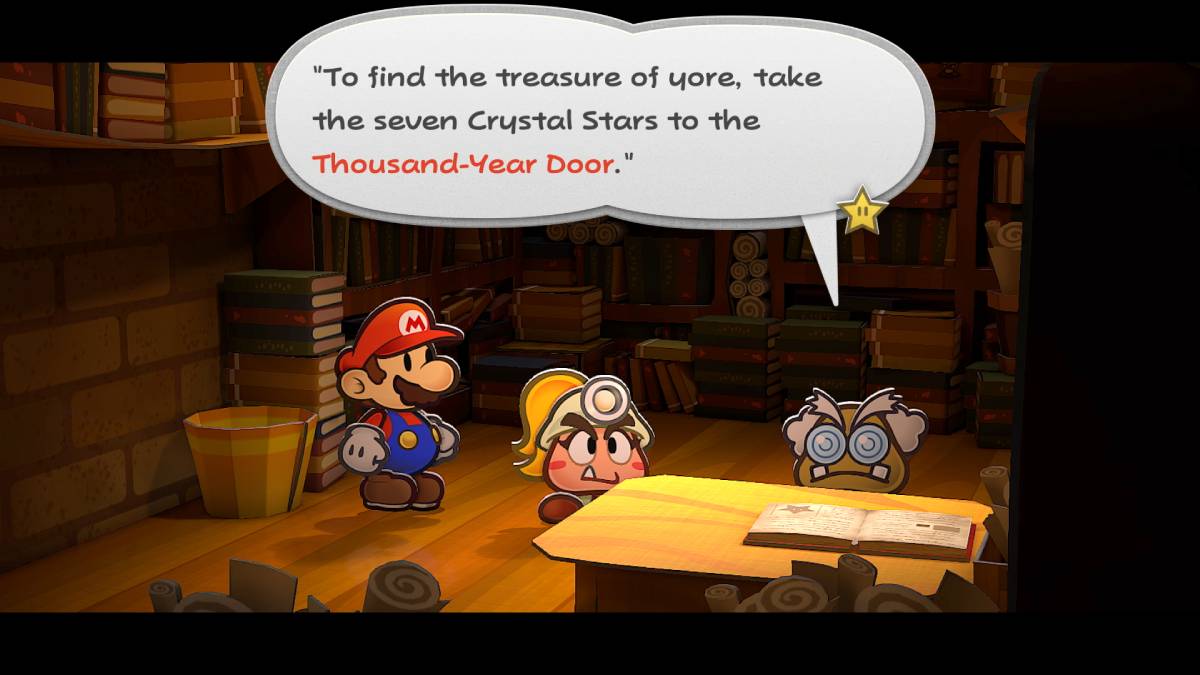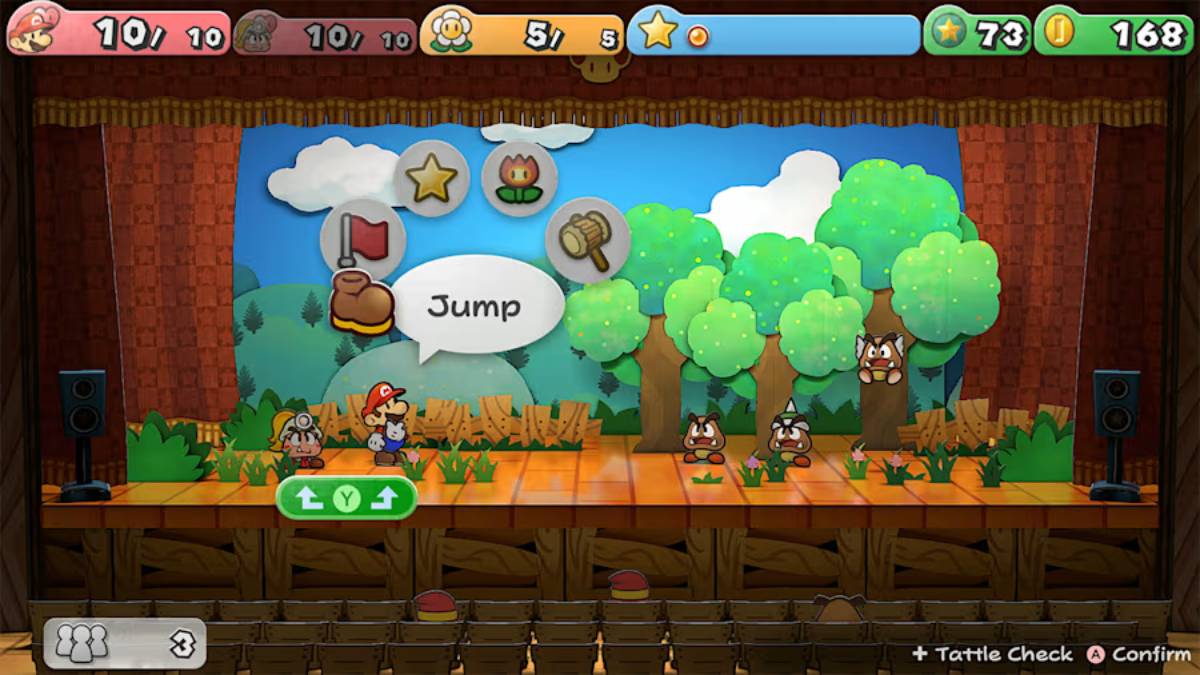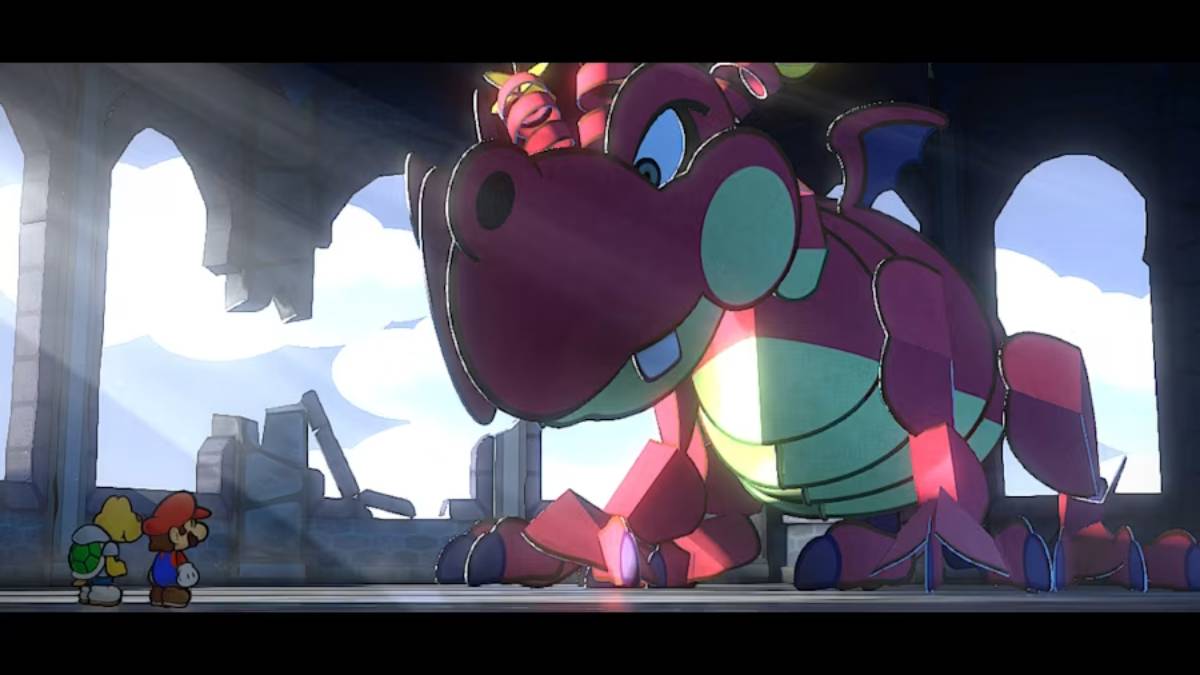Whenever we get a remake or a remaster of a game, there’s always the question of if it will hold up. Is it only nostalgia that endears a title that is potentially actually a flawed work to us? Have modern innovations and quality of life changes across the industry left it behind? After spending over 30 hours playing Paper Mario: The Thousand Year Door on the Switch, I can assure you that it remains a masterpiece and is now one of best RPGs on the Switch.
Princess Peach is stopped in the unsavory town of Rogueport when she happens upon a strange map showing the location of legendary Crystal Stars. She sends it off to Mario and asks her to meet him at the city. However, she’s gone by the time he gets there. His only way to reunite with her and solve the mystery of the town’s Thousand-Year Door is to use the map to collect the stars and open it.

While Paper Mario on the N64 helped build a foundation, Paper Mario: The Thousand-Year Door finely tunes it to perfection. Following the introduction, during which Mario is the only lead, the narrative is split between the perspectives of Peach and Bowser as well. (But not Luigi, though you can catch up on his Waffle Kingdom escapades by talking with him in Rogueport.) Each chapter involves a new location and situation, though getting the Crystal Star from that area won’t involve the same protocol each time. The Petalburg region one involves traditional JRPG elements like going through a castle and facing a draconic boss. However, the Glitzville one turns Mario into an up-and-coming arena fighter to earn a belt with the Crystal Star while investigating mysteries at the arena.
Paper Mario: The Thousand-Year Door also builds on the lovely, turn-based battle system from Paper Mario that incorporates a little more action, while also not making level-grinding and fighting the focus. Mario levels up, but damage tends to remain consistent. Heart Points for health, the Flower Points tied to skills, and Badge Points for equipping influential badges are the only stats to worry about. His allies rank up once you collect Shine Sprites and talk to Merlon, who then increases their power and moveset. You see these fights on the map and, even if you’ve been avoiding battles, can tend to power through if you really want to try.

However, battles are genuinely fantastic. Mario and his active partner character appear on the field. Each turn, the two of them act. They can attack, which may or may not require FP, use items, and use tactics to appeal to the audience, swap the partner, charge up attack power, or defend. Mario can also use Specials. It’s also possible to swap which of the two characters acts first.
Enemies tend to be broken up into ones that could only be hit by jumping or airborne attacks, ones that require hammer or hitting attacks, and ones that may need a special circumstance like an item or Yoshi’s Gulp maneuver. All attacks involve an additional input, once selected, to carry them out properly or deal extra damage. So even though it is a turn-based battle scheme, there’s more direct involvement. As everything is set up as though there is an audience watching the fight like a play, props or items could fall down when allies attack. Audience members could throw helpful or harmful items. Appealing could result in the audience assisting.
Speaking of partners, they and Mario’s “curses” are tied to light puzzles and platforming in the environments. One of Mario’s earliest overworld abilities involves turning into a paper airplane to cross specific gaps. Eventually, he’ll also learn how to do things like ground-pound or turn on his edge to go between gaps. Koops allows you to grab distant items or hit switches. When Mario rides on Yoshi, you can ride on him and flutter jump over gaps. Acquiring them grants greater access to Rogueport’s underground areas and sometimes even past places.
But what it all comes down to is personality. Paper Mario: The Thousand-Year Door is from an age when the Paper Mario series wasn’t filled with lifeless, sometimes even generic or tedious, entries like Paper Mario: Sticker Star or Paper Mario: Color Splash. Every NPC looks and feels distinct with a personality, even if they are based on a typical Goomba or Koopa. Trooper. The situations are clever and humorous. It all feels so alive, funny, and happy. You want to talk to everyone. Explore every corner of cities. Savor the moment.

I will say that, for the most part, this is a fairly straightforward remake of the original Paper Mario: The Thousand-Year Door for the Switch. There are some new elements included. The majority of these are quality of life or unification features. For example, it is easier to swap between allies in the field, as you do so with the press of a button. There’s a tutorial character who pops up in most major towns, so you can practice moves and timing. A certain badge now makes Mario’s hammer attacks sound like a frog worldwide. A few other surprises do come up, which I think folks will appreciate, but I don’t want to spoil anything for anyone. I suppose a part of me did wish Luigi had his own story segments like Bowser and Peach’s, but in a way it’s much better to relegate his adventures to stories to continue the running joke.
Paper Mario: The Thousand-Year Door is both the best Paper Mario entry and a Switch game everyone should own and play. The story is wonderful. The characters are fantastic. The gameplay is never tedious, and the situations often involve delightful surprises or twists. Nintendo, for whatever reason, literally does not make Paper Mario games like this anymore, as evidenced by entries like Paper Mario: The Origami King, and that is a criminal act. But at least we have this wonderful game for more people to play again. Who knows, maybe if it sells well enough, Nintendo will get Intelligent Systems to work on a fresh entry that is more like the N64 original and this gem.
Paper Mario: The Thousand-Year Door will come to the Nintendo Switch on May 23, 2024.
The nefarious X-Nauts are after the treasure behind the Thousand-Year Door! With a map from Princess Peach, and the help of a few locals, Mario journeys through a colorful world made of paper to find them first. To prevail in this quest, you’ll have to level up Mario and his friends, master timing-based attacks and badges to impress the audience on the stage of combat, and make use of all the abilities that come with being cursed—er, conveniently made of paper—like folding into a plane to cross big gaps or turning sideways to slip through narrow openings. Switch version reviewed. Review copy provided by company for testing purposes.
Paper Mario: The Thousand-Year Door is both the best Paper Mario entry and a Switch game everyone should own and play.


Published: May 21, 2024 09:00 am